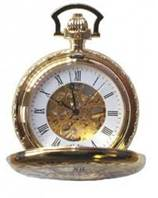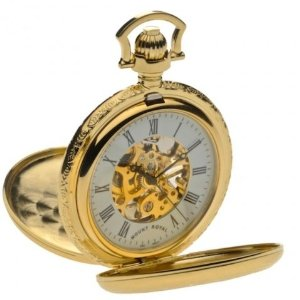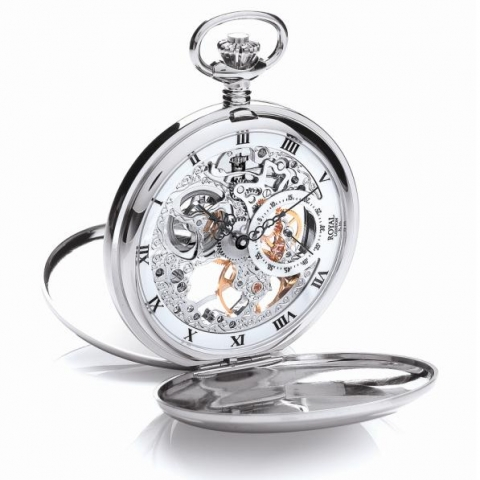 I recently found out my grandmother is going to give me my grandfather’s pocket watch when she sees me next month. I don’t recall ever seeing it, so I have no idea what it looks like, except that it’s gold. I’m really excited about getting it; not just because it belonged to my awesome grandfather who I always loved and admired, but because pocket watches are making a comeback. I can’t wait to see which suits I can pair it up with, and having never owned or wore a pocket watch before, I look forward to experimenting with ways to wear it.
I recently found out my grandmother is going to give me my grandfather’s pocket watch when she sees me next month. I don’t recall ever seeing it, so I have no idea what it looks like, except that it’s gold. I’m really excited about getting it; not just because it belonged to my awesome grandfather who I always loved and admired, but because pocket watches are making a comeback. I can’t wait to see which suits I can pair it up with, and having never owned or wore a pocket watch before, I look forward to experimenting with ways to wear it.
So, in anticipation of the arrival of my newly inherited family heirloom, I decided to educate myself more about pocket watches and share the information with you, in case you ever decide to add this nostalgic and very classy accessory to your arsenal.
Pocket Watch History
The first watch was invented in the early 1500s by a German locksmith, Peter Heinlein, who found a way to take stationary, upright clocks with falling weights to portable timekeeper status. Made of iron, the original watch had only the hour hand, and was so heavy it was either worn around the neck or fastened around a belt with a cord or chain. Talk about real men! Then in the late 16th century, watches began being made of brass, and with technology advancements, were able to be made small and light enough to fit into a jacket or vest pocket. Pocket watches were the only type watch available, and because they were handmade, were a very expensive luxury item limited to merchants and the wealthy.
Very inaccurate until the invention of the minute hand during the late 17th century, the pocket watch remained the most popular and fashionable watch available for the next two centuries. Most watches and clocks were made in Germany and France back in the day; however, it did not take long for this incredible invention to spread throughout the world. Thanks to Aaron Lufkin Dennison, who invented the mass production of pocket watches in the mid-1800s, men from all walks of life became the proud owners of this amazing invention that hung from a chain. Eventually, the development of the second hand came later in the 19th century, and up until World War 1 when wrist watches were invented (for women only!), pocket watches were still the only form of portable timekeeping.
Today, we take watches and clocks for granted, not realizing how much energy and technology went into making these very common devices, which most of us live our lives by. There is tons of additional information about pocket watches online if you’d like to know more, so for now, I’m going to end the history lesson and move onto…
How to Wear a Pocket Watch
Regardless if you own an antique or a new modern design, pocket watch wearing follows traditional rules:
- Choose a thick, sturdy chain that matches the watch’s metal – never mix gold and silver, etc. If you’re going to purchase a pocket watch and not inherit one like I will, choose a metal that matches the majority of your other jewelry, so there is continuity.
- When choosing a watch, factor in the color of your suits. If you usually wear grey, blues, or black – consider silver, stainless, pewter, or titanium metals. If you wear brown suits – gold, brass, and copper watches would keep in the same color family. These are not hard, fast rules, but just food for thought. Whatever your choice, be sure your jewelry metals match like you do when wearing a wrist watch.
- The chain should have a T-bar if the watch will be kept in a vest or jacket pocket. Hook the chain to the loop on the watch, so that the T-bar is opposite the watch. The purpose of the T-bar is to secure the chain and watch to your jacket or vest.
- Place the T-bar behind the buttonhole of the jacket or vest.
- Once securing the T-bar, place the pocket watch inside the inner vest or jacket pocket on the same side as your non-dominant hand… which would be the hand you do not write with. The reason for this is so you can pull the watch out with your dominant hand when checking the time. Once the watch is in place, a small U-shaped section of chain should be hanging out over the vest or jacket. It’s a pretty cool look.
- One alternative to wearing a pocket watch with a T-bar chain is a chain with a clasp. The clasp should be securely hooked to a belt loop. This is a more casual style, permitting the watch to hang outside the pant pocket if desired. However, be sure the clasp is a good one, so you don’t lose the watch.
- A fob is a short chain, leather strap, ribbon, or other similar device that attaches to the pocket watch and connects to your clothing. No matter what you choose to use, make sure it’s reliable, since it’s your security line to the watch.
Types of Pocket Watches
Open-Faced – These watches have no cover or lid to them, which exposes the face of watch.
Full-Hunter Style – These do have covers, which need to be opened to read the time. Covers are usually very ornate and fancy.
Half-Hunter Style – This type watch also has a cover, but in the center is a crystal, which makes viewing the time possible without opening the cover.
Double-Hunter Pocket Watch – This watch has the same style cover as the Half-Hunter, and also has a lift-able cover on the back of the watch, so you can see the inside workings of the watch. The back can be opened to stand the watch up, which is handy if you want to keep it upright on a table.
Double-Half Hunter Style – This watch has the same features as the Half and Double Hunters with one additional feature – a covered opening on the front of the watch that allows both the hands and inner workings of the watch to be seen.
I’m really excited to own a pocket watch. Nothing completes a suit, especially a three piece suit, like a pocket watch. It’s classy and screams sophistication and impeccable style – something we all want when maxed out in a suit… no matter what our age. I have seen guys in jeans wearing pocket watches both in vest pockets and jeans pockets; however, the pocket watch should be reserved for wearing with suits. Wearing a pocket watch with jeans (or other casual outfits) is like wearing dress shoes with jeans. Definitely not a good look. I’ll do a video on pocket watches when my Nana honors me with my grandfather’s watch. Until then, I hope time is on your side!
by Aaron Marino


















